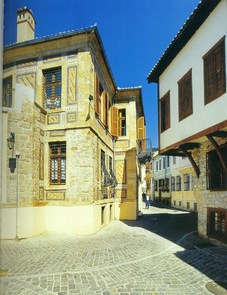General Information on Xanthi
Xanthi is located in the north of Greece, 220km east of Thessaloniki. It is one of the most beautiful Greek cities and the cultural capital of Thrace. The city was founded in the 11th century and has an oriental feel to it, which may be due to the fact that the town has a significant Muslim population.
Xanthi is a lively town with many bars and cafes, fuelled by a university presence. However, the city’s charms are most apparent in its old, Turkish-influenced upper town. The narrow stone alleys, reminiscent of Greek islands, lend an eloquent and unique touch of civility to an enclave that was quite a wealthly commercial centre during Ottoman times. While the more visited coast is not too far away, Xanthi is worth a visit. It is a destination for all seasons, as it boasts one of the most famous winter carnivals in Greece, while Easter and numerous other religion-inspired festivities, as well as musical and theatrical performances, are organised during spring and summer months.
History of Xanthi
According to Greek mythology, Thrace was a very significant region. It was the base of Aris, God of War, and of Voreas, Orpheus and Dionysus.
The area of southwestern Thrace has been inhabited since Neolithic times. Settlements and objects have been spotted in the plains of Xanthi dating back to 4500 B.C. During the Bronze Age, the region was influenced by Troy, Lesbos and Lemnos and it contributed into the diffusion of civilization to the west and north. References to Xanthi in particular date back to 879 B.C. It began as a small village and experienced all the tumultuous periods of the history of Thrace, such as raids, disasters, race conflicts and civil wars.
The population of the region had dwindled down to almost nothing and almost everything had been destroyed. When the Ottomans took control of Greece, the region of Xanthi was almost completely deserted. The Turks brought settlers from Asia Minor who created the settlement of Genisea, while Oreo and Xanthi remained mainly Greek and Christian centres. The general development of the area during the years of the Ottoman occupation is related to the cultivation of tobacco after the 17th century. In the 18th century, Genisea and Xanthi became known worldwide due to the growing of tobacco. In March and April of 1829, two earthquakes literally leveled the city. However, the incident played a decisive role in its further development. In 1870, the village of Genisea was burned down and thus all of the services were transferred to Xanthi which, at the time, had a population of about 10,000 inhabitants.
During the Macedonian and Thracian War, in the early twentieth century, the citizens of Xanthi took part in secret organizations of resistance. The Bulgarians took the city of Xanthi in 1912, but after a period of eight months, it was taken back by the Greek army. Shortly after the Greek reoccupation, as part of the treaties after the Balkan Wars, Xanthi and Western Thrace were ceded to Bulgaria, and remained under its control until the end of World War I. This was a period of allied occupation until May 1920, when the entire northwestern Thrace became officially part of the Greek State. During World War II, the front at Thrace collapsed and the region was taken by the Bulgarians once again. The inhabitants that remained suffered greatly until 1944, when the Greek army took back the region.
After the liberation, the region experienced many difficulties, such as economic problems, great emigration rates and general underdevelopment. The situation only started to change when the Democritus University of Thrace was founded and the fourth Army Corps was established. Gradually, the region started to develop again and with the settlement of refugees from the former Soviet Union, the population increased.
How to Reach Xanthi
Air: Xanthi shares the Hrysoupolis airport 47km away, with Kavala. There are daily flights to Athens with Olympic Airways and Aegean Airlines. During summertime, charter flights connect Xanthi to many European cities.
Bus: From the bus terminal buses go to Komitini (45 minutes), Thessaloniki (4 hours) via Kavala (1 hour) and Athens (10 hours).
Train: Trains go to Alexandroupolis (1 ½ hours) and Thessaloniki (4 hours).
Top 10 Destinations in Xanthi
All Destinations in Xanthi
Map of Xanthi
 Athens Photos
Athens Photos
 Santorini Photos
Santorini Photos
 Crete Photos
Crete Photos
 Meteora Photos
Meteora Photos
 Corfu Photos
Corfu Photos





































































